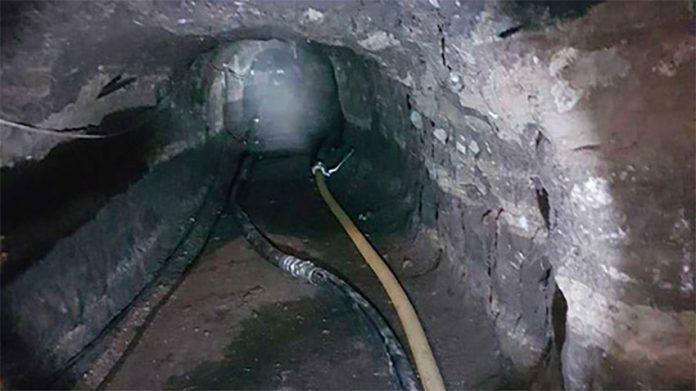Amid an ongoing crackdown on fuel theft, Mexico’s petroleum plunderers are going underground – literally: they have built tunnels in at least three states to transport stolen fuel.
According to a report by the newspaper Milenio, huachicoleros, as fuel thieves are known colloquially, have had to rethink their modus operandi in order to sustain their illicit business while the army, navy and National Guard carry out air and land operations against them.
Tunnels, infrastructure that drug cartels have used extensively to move their product across the northern border into the United States, are one part of their new strategy.
Federal security authorities in conjunction with the state oil company Pemex have uncovered fuel transportation tunnels in San Martín Texmelucan, Puebla – part of the so-called Red Triangle, a region notorious for the tapping of petroleum pipelines, Cadereyta, Nuevo León, and the Guanajuato municipalities of Apaseo el Grande and Apaseo el Alto.
Fuel thieves use hoses that run through the tunnels to transport petroleum extracted illegally from tapped pipelines.
The tunnels, located just under the ground’s surface, have exit points at locations away from the Pemex pipelines where thieves can more easily avoid the prying eyes of authorities and safely make off with their stolen fuel – at least until the tunnels are discovered.
Now that the authorities have become aware of the huachicoleros‘ subterranean strategy, the security forces tasked with combating the lucrative fuel theft racket have a new mission: ferret out more tunnels.
A Pemex security director told Milenio that finding the tunnels is not as hard as it might seem.
“The smell of fuel is very strong, very acute, and that’s one of the main signs that allows us to detect … an illegal extraction,” Netzahualcóyotl Albarrán Mendoza said. He said the tunnels that have already been found were located not long after they were built.
Fuel thieves have not only relied on their own purpose-built tunnels to move stolen petroleum in secret: they’ve also used infrastructure built for licit purposes.
Authorities told Milenio that fuel thieves have made use of a 3.7-kilometer section of an incomplete, non-operational natural gas pipeline built by TC Energy (formerly TransCanada Corporation) in Hidalgo.

Located just two kilometers from the state-owned refinery in Tula, the section of pipeline used by thieves to transport fuel runs parallel to a Pemex duct.
The army not only detected that huachicoleros were opportunistically using the TC Energy pipeline but is also in the process of recovering some 2 million liters of stolen fuel still in it. Once recovered, the fuel will be decontaminated and returned to Pemex storage facilities.
Col. Humberto Bautista said Monday that the recovery of the stolen fuel will be the largest since the federal government implemented a new strategy against fuel theft 18 months ago.
He said that air and land-based security operations have been successful in “considerably” reducing fuel theft, a crime that formerly cost Pemex 30 billion pesos (US $1.3 billion at today’s exchange rate) a year, according to former CEO Carlos Treviño.
President López Obrador and current Pemex CEO Octavio Romero have asserted that fuel theft has declined significantly on their watch, although it remains a problem for the heavily-indebted state oil company.
López Obrador said earlier this month that theft had been reduced from 80,000 barrels a day when he took office to just 3,000 barrels a day, a 96% decline.
He claimed that fuel theft will soon end because there is no longer collusion between Pemex and fuel thieves, who like their drug trafficking cousins have inspired a genre of outlaw music.
Considering the authorities’ recent discoveries, it might not be too long before a new huachicorrido – a ballad that tell the stories of fuel thieves – celebrating their tunnel digging prowess makes an appearance online.
